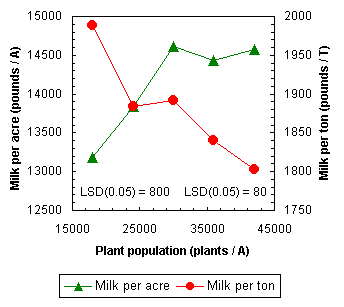How thick should corn be planted for silage production?
April 24, 1997 4(6):36
Joe Lauer and Jorge Cusicanqui
Corn Agronomist and Research Assistant
Typical harvested plant population recommendations for corn grain in Wisconsin
range between 28,000 and 32,000 plants per acre. If your fields have lighter soils
then 26,000 plants per acre is about right. If you are planting extra early, plant
2,000 to 3,000 more kernels per acre than you would on a normal planting date due
to: 1) greater seedling mortality, 2) plants grow shorter and tend to lodge less,
and 3) moisture supply is more likely to be adequate during pollination. Hybrids
react differently, so check with the seed company. They know the population tolerances
of their hybrids and make recommendations accordingly.
The effects of high plant population are less important for corn silage production
because lodging is less of a concern. In the past, fields harvested for silage were
typically planted at rates of at least 10% more than what was recommended for grain.
Even higher plant populations could obtain higher yield of green weight, but this
practice produces little advantage in dry weight. Typically grain yield decreased
drastically at these extremely high plant populations.
Many workers have reported consistent dry matter yield increases with increasing
plant population. Quality changes have been less consistent. In general, as plant
populations increase, fiber levels increase and digestibility decreases. Some studies
report no significant silage quality changes over a fairly wide range of populations.
In Wisconsin, a study about the influence of plant population on corn silage yield
and quality was conducted during 1994, 1995 and 1996 at six locations. High and
low quality hybrids were evaluated at five plant populations between 18,000 to 42,000
plants per acre.
Preliminary results from 1994 and 1995 indicate that whole plant yield increases
with increasing plant population through this entire population range (Table 1).
Significant but small changes in quality were observed. Neutral detergent fiber
and acid detergent fiber increase slightly as plant population increased. Crude
protein and in vitro digestibility decreased as plant population increased.
|
Table 1. Plant population effect on corn silage yield and quality grown at six Wisconsin
locations during 1994 and 1995.
|
Plant
Population
|
Silage Yield
|
Crude
protein
|
ADF
|
NDF
|
In vitro
digestibility
|
|
Plants/A
|
Tons DM/A
|
%
|
%
|
%
|
%
|
|
18000
|
6.7
|
7.5
|
23.2
|
46.2
|
77.5
|
|
24000
|
7.4
|
7.1
|
24.1
|
47.3
|
76.7
|
|
30000
|
7.8
|
7.0
|
24.3
|
47.2
|
76.7
|
|
36000
|
8.0
|
7.0
|
24.7
|
47.9
|
76.4
|
|
42000
|
8.3
|
6.9
|
25.2
|
48.3
|
76.0
|
|
LSD(0.05)
|
0.3
|
0.2
|
0.8
|
1.2
|
0.7
|
How do these small changes in silage quality affect overall production? Silage performance
was evaluated using the indices of milk per ton and milk per acre
(Undersander, Howard and Shaver, 1993). The index of milk per ton is a "quality"
estimate using fiber, protein, and digestibility parameters, while milk per acre
is a "production" estimate where the milk per ton is multiplied by yield.

In this experiment milk per ton decreased as plant population increased (see Figure).
Milk per acre increased until 30,000 plants per acre and did not change with higher
plant densities. This suggests that maximum milk production might be achieved using
a population of 30,000 plants per acre which is similar to optimum populations for
grain production.
Key References
Carter P., J. Coors, D. Undersander, K. Albrecht, and R. Shaver. 1991. Corn hybrids
for silage: an update. p. 141-164. In Wilkinson D. (ed.) Proc. of the Forty-sixth
Annual Corn and Sorghum Industry Research Conference. Chicago, IL. 11-12 Dec. 1991.
American Seed Trade Association Washington, D.C.
Cox, W.J. and O.R. Crasta. 1993. Grain and silage yield responses of commercial
corn hybrids to plant densities. p 132. In Agronomy abstracts. ASA, Madison,
WI.
Karlen D., and C. Ramp. 1985. Plant density, distribution, and fertilizer effects
on yield and quality of irrigated corn silage. Commun. In Soil Sci. Plant Anal.,
16(1):55-70.
Olson, R., and D. Sander. 1988. Corn production. In Corn and corn improvement.
Agronomy. ASA, Madison, WI.
Roth, G., and D. Undersander. 1995. Corn silage production, management, and feeding.
Library of Congress Cataloging-in-Publication Data.
Sanderson, M., R. Jones, J. Read, and H. Lippke. 1995. Digestibility and lignocellulose
composition of forage corn morphological components. J. Prod. Agric. 8:169-174.
Undersander, D.J., W.T. Howard, and R.D. Shaver. 1993. Milk per acre spreadsheet
for combining yield and quality into a single term. J. Prod. Agric. 6:231-235.